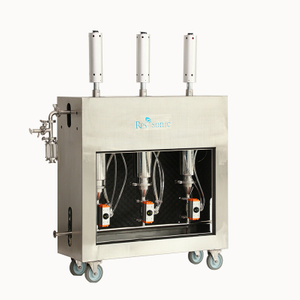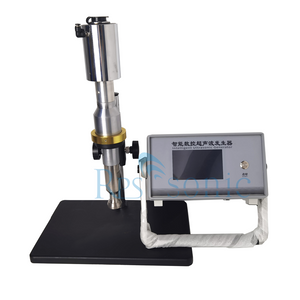The present invention relates to a method for producing biodiesel through methanol esterification using ultrasound. Using various animal waste fats, waste cooking oil from the restaurant industry, and waste cooking oil as raw materials, the method accelerates methanol esterification through the cavitation, heating, and high-frequency oscillation effects of ultrasound to produce biodiesel. Advantages of the method include increasing the activity of the reactants by adjusting the ultrasound intensity, thereby improving the methanol conversion rate; using various waste animal and vegetable fats, waste cooking oil from the restaurant industry, and waste cooking oil as raw materials, resulting in low cost; and eliminating the use of any catalyst, thus avoiding environmental pollution caused by catalyst handling. No modification or adjustment is required to existing biodiesel production equipment, and high-temperature and high-pressure equipment is not required during the reaction process, simplifying the production process and reducing production costs.
Biodiesel is a new type of fuel produced from animal and vegetable fats. According to chemical analysis, biodiesel fuel is a high-fat methane obtained by decomposing glycerides with unsaturated oleic acid C18 as the primary component. Compared to conventional diesel, biodiesel surpasses conventional diesel in cold filter plugging point, flash point, combustion efficiency, sulfur content, oxygen content, combustion oxygen consumption, and water pollution, while other indicators are comparable. Due to its unparalleled environmental performance, excellent low-temperature engine starting performance, superior lubricity, safety, fuel efficiency, and renewable nature, engines powered by biodiesel meet not only the current Euro II emission standard but also the more stringent Euro III standards that will soon be implemented in Europe. Furthermore, because biodiesel emits far less carbon dioxide than plants and animals absorb during their growth, it contributes to global warming, a major environmental problem that is harmful to humanity. Therefore, biodiesel is a truly green diesel. Commercial biodiesel production bases have been established in several countries and regions in the United States, Europe, and Asia, and biodiesel is widely used as an alternative fuel.
Common biodiesel production methods include the following:
1. Pyrolysis: This method uses high temperatures to break down the long-chain molecules of animal and vegetable oils into shorter molecules, converting high-molecular-weight organic matter into relatively simple hydrocarbons. The cracking products are similar to conventional diesel. However, the pyrolysis process is complex and requires bulky equipment, resulting in high production costs and limited commercialization.
2. Transesterification: This is currently the most commonly used method. Under acid (or alkaline) catalysts and high temperatures (230-250°C), alcohols such as methanol or ethanol undergo a transesterification reaction with triglycerides, the main components of natural vegetable oils or animal fats. Methoxy groups replace glyceryl groups on long-chain fatty acids, reducing the oil's viscosity and improving its flowability and vaporization properties, meeting the requirements for fuel use. However, the following drawbacks exist:
① The acid (or base) catalyst is difficult to recover;
② The free fatty acid and water content significantly influences the acid (or base) catalytic reaction;
③ The process is complex, requiring an excess of alcohol, necessitating alcohol recovery equipment in subsequent processes and resulting in high energy consumption;
④ The color is dark because unsaturated fatty acids in fats are susceptible to deterioration at high temperatures;
⑤ The esterification product is difficult to recover, resulting in high costs; and ⑥ The production process involves the discharge of waste alkali liquid.
3. Supercritical Non-Catalyst Methanol Esterification: This method produces biodiesel through a catalyst-free methanol esterification process at a supercritical temperature of 350-400°C and a pressure of 45-65 MPa. While this method simplifies the difficulty in separating the products of the traditional transesterification reaction and addresses the long reaction time associated with conventional catalyst-free methanol esterification, it is complex, requires bulky equipment, and results in high production costs.
The present invention aims to overcome the shortcomings of the above-mentioned prior art biodiesel production methods, thereby providing a simple, low-cost method for producing biodiesel through methanol esterification using ultrasound, which eliminates the use of catalysts and organic solvents and achieves a high methanol conversion rate.
The present invention provides a method for producing biodiesel by methanol esterification using ultrasound. The method utilizes various animal waste fats, waste cooking oils from the restaurant industry, and waste cooking oil as raw materials. Ultrasonic cavitation, heating, and high-frequency oscillation accelerate methanol esterification to produce biodiesel. The method comprises the following steps:
1) Methanol and raw oil are mixed in a molar ratio of 20 to 50:1, and an ester exchange reaction is carried out at 40°C to 64°C, a stirring speed of 1500 to 2000 rpm, an ultrasonic power of 2 kW to 10 kW, and an ultrasonic frequency of 20 to 60 kHz for no more than 2 hours.
The raw oils include various animal waste fats, waste cooking oils from the restaurant industry, and waste cooking oil.
2) The mixed solution after the reaction is allowed to stand for at least 8 hours, allowing the mixed solution to separate into layers and separating the glycerin in the lower layer.
3) The upper layer of the mixed solution is distilled at 70 to 100°C until all the methanol is recovered. The remaining distillate is the biodiesel. The method for producing biodiesel by methanol esterification using ultrasound, provided herein, utilizes the cavitation, heating, and high-frequency oscillation effects of ultrasound during the biodiesel production process. Microscopic gas nuclei (cavitation nuclei) present in the methanol and feedstock oil mixture undergo a dynamic process of high-frequency vibration, growth, and collapse and closure under the influence of the ultrasonic sound field. When the cavitation bubbles collapse, they generate localized high temperature and high pressure in the extremely small space surrounding them within a very short period of time. The high temperature increases the activity of the reactants, promoting the formation of free radicals and the occurrence of cracking reactions; the high pressure generates shock waves and microjets, resulting in intense collisions between molecules, thereby accelerating the complete chemical reaction of methanol esterification to produce biodiesel.
Compared with existing technologies, the advantages of the method provided by the present invention are:
1) By adjusting the ultrasonic intensity generated by the ultrasonic oscillator, the activity of the reactants is increased, promoting the formation of free radicals and the occurrence of cracking reactions in the reactants. This also creates strong collisions between reactant molecules, accelerating methanol esterification and improving the methanol conversion rate.
2) The present invention can use various waste animal and plant oils, waste cooking oil from the catering industry, and waste oil such as gutter oil as feedstock, resulting in low cost.
3) The present invention does not use any catalysts, thus avoiding environmental pollution caused by catalyst handling.
4) This method does not require modification or adjustment to existing biodiesel production equipment, and does not require high-temperature and high-pressure equipment during the reaction process, simplifying the production process and reducing production costs.


 English
English














